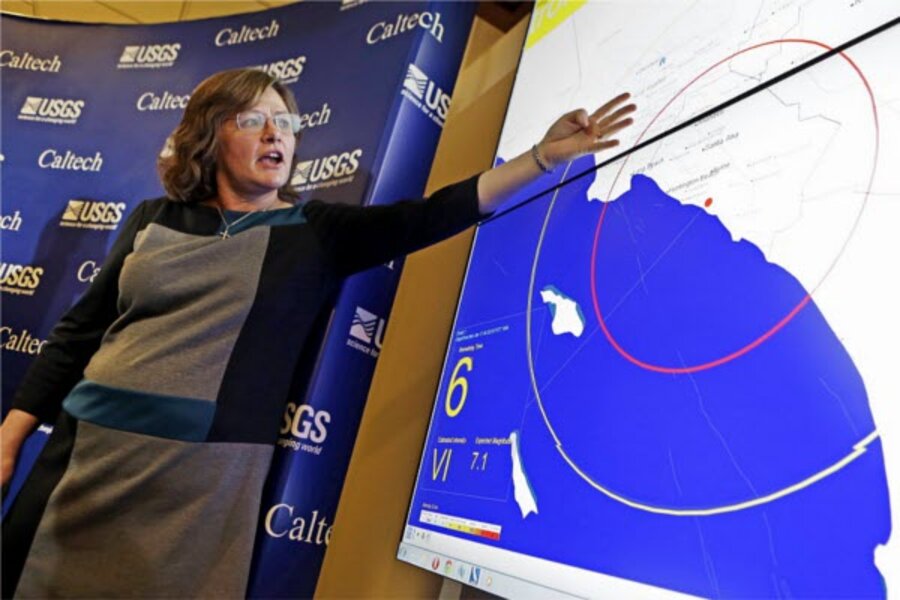Pacific earthquake: Are scientists underestimating 'superquakes'?
Loading...
The 8.0 Pacific quake that hit the Solomon Islands tonight should be about most powerful earthquake possible, according to seismologists' theories of earthquake cycles. And the earthquakes that rocked Tohoku, Japan in 2011, Sumatra in 2004, and Chile in 1960 — all of magnitude 9.0 or greater — should not have happened. That might mean earthquake prediction needs an overhaul, some researchers say.
All these earthquakes struck along subduction zones, where two of Earth's tectonic plates collide and one dives beneath the other. Earlier earthquakes had released the pent-up strain along Chile's master fault, meaning no big quakes were coming, scientists had thought. Japan and Sumatra both sat above on old oceanic crust, thought to be too stiff for superquakes.
And records of past quakes, combined with measurements of the speed of Earth's tectonic plates, suggested the Tohoku and Sumatra-Andaman regions couldn't make quakes larger than 8.4, almost nine times smaller than a magnitude 9.0 temblor.
"These areas had been written off as places incapable of producing a great earthquake," said Chris Goldfinger, a marine geologist at Oregon State University in Corvallis.
But the events of 1960, 2004 and 2011 showed that these faults were capable of producing some of the most destructive earthquakes in recorded history, suggesting earthquake researchers need to re-think aspects of how they evaluate a fault's earthquake potential.
"It's time to come up with something new," Goldfinger told OurAmazingPlanet.
Faults are like batteries
When two tectonic plates collide, they build up strain where a fault sticks, or locks, together. Earthquakes release this strain, which is a form of energy.
For decades, scientists assumed faults acted like rubber bands, steadily building up strain and then releasing it all at once, Goldfinger said. The longer the time since the last earthquake, the larger the next earthquake would be, the model predicted.
The problem was researchers failed to recognize that faults can store energy like a battery, Goldfinger said. And just like batteries, they can discharge energy in small amounts, or all at once, he explained.
Goldfinger and other researchers now think if a "small" quake hits, it may not release all of the accumulated energy in a fault. (On a subduction zone, a small quake can still register in the magnitude-8.0 range, which is devastating to nearby cities.)
Thus, a fault can "borrow" stored energy from previous strain-building cycles, generating larger earthquakes than expected, such as those that hit Sumatra and Tohoku, Goldfinger and his colleagues propose in a study published in the January/February 2013 issue of the journal Seismological Research Letters.
"Those models were already being called into question when Sumatra drove one stake through their heart, and Tohoku drove the second one," said Goldfinger, the lead author of the study.
Superquakes and supercycles
Goldfinger said scientists' failure to recognize that faults could store energy comes from a lack of data. Historic earthquake records go back only 100 years, he noted. Geologists are only now getting histories that reach back thousands of years, via techniques that decode evidence of past earthquakes in sediments.
"What is happening on a short-term timescale is actually imposed on a long-term cycle," he said.
Goldfinger calls these long-term histories supercycles, and the unusually large and rare earthquakes that discharge the battery are superquakes. The sequence, size and location of quakes vary from one supercycle to the next, he said.
Seismologist Marco Cisternas first proposed that faults could store energy in 2005, with a study showing that the magnitude 9.5 Chile earthquake in 1960, the largest on record, released more energy than had been stored since its most recent quake, in 1837. Tsunami deposits in Chile indicate the last superquake occurred in 1575, and smaller quakes since then had only partly released the strain built up on the fault, his study found.
In Sumatra, south of the Andaman region, analyses of corals uplifted and killed during earthquakes also indicated that the subduction zone undergoes supercycles, according to a 2008 study led by geologists at the Earth Observatory Institute in Singapore. Each series of quakes in the region lasts between 30 and 100 years, according to the study. The supercycles unfold every 200 years or so.
Forecasting the future
Goldfinger and his colleagues have evidence that the Cascadia Subduction Zone, which stretches from Northern California to British Columbia, is also in the middle of an earthquake supercycle.
Over the past 10,000 years, 19 superquakes and four supercycles have occurred along the zone, Goldfinger said.
"These would typically be of a magnitude from about 8.7 to 9.2, really huge earthquakes," Goldfinger said. "We've also determined that there have been 22 additional earthquakes that involved just the southern end of the fault. We are assuming that these are slightly smaller, more like 8.0, but not necessarily. They were still very large earthquakes that if they happened today could have a devastating impact," he said.
The present cycle seems like it's gently ratcheting downward, Goldfinger said. "This would suggest that we're not due for a giant [quake] anytime soon, but the model has no predictive value," he said.
The battery model of earthquake energy storage and discharge makes it difficult for scientists to forecast future earthquakes, as there's no explanation yet for why faults would behave this way, Goldfinger said. Plus, it's hard to say how much energy a fault's battery stores. "We haven't yet figured out how to effectively put a voltmeter on a fault and say how charged it is," Goldfinger said.
But with more detailed records of past earthquakes, such as those in Sumatra and Cascadia, Goldfinger believes scientists can give better estimates of seismic hazards, and prevent surprises like Sumatra and Tohoku.
"The long records are revealing very useful things," he said. "We're not sure what's driving the long-term cycling, but at least we can tell people what to prepare for," Goldfinger said.







